Rethinking Giftedness: Beyond IQ Scores and Stereotypes
1 year ago
Giftedness
Overcoming Disordered Eating: A Step-by-Step Guide
1 year ago
Disordered Eating
Unraveling the Science Behind Breaking Bad Habits
1 year ago
Breaking Bad Habits
How Can Schools Effectively Prevent Bullying?
1 year ago
Bullying Prevention
Mastering Body Language: The Comprehensive Guide
1 year ago
Body Language Basics
Step-by-Step Guide to Managing Toxic Relationships
1 year ago
Managing Toxic Relationships
5 Effective Steps to Overcome Procrastination
1 year ago
Procrastination Overcome
Mastering the Mindset: My Journey to Embracing Success Psychology
1 year ago
Success Psychology
How Can You Effectively Manage Holiday Stress?
1 year ago
Holiday Stress
Exploring the Science of Personal Growth: Key Research Findings
1 year ago
Personal Growth
Decoding Adult Attachment: A Personal Insight
1 year ago
Understanding Attachment in Adults
Decoding Your Dreams: A Step-by-Step Guide to Understanding Their Meanings
1 year ago
Dream Interpretation
The Psychological Impact of a Digital Nomad Lifestyle
1 year ago
Digital Nomad Psychology
Understanding Stress vs. Anxiety: A Comprehensive Guide
1 year ago
Stress vs Anxiety
Breaking Barriers: An Interview with a Diversity Expert on Confronting Bias
1 year ago
Confronting Bias















